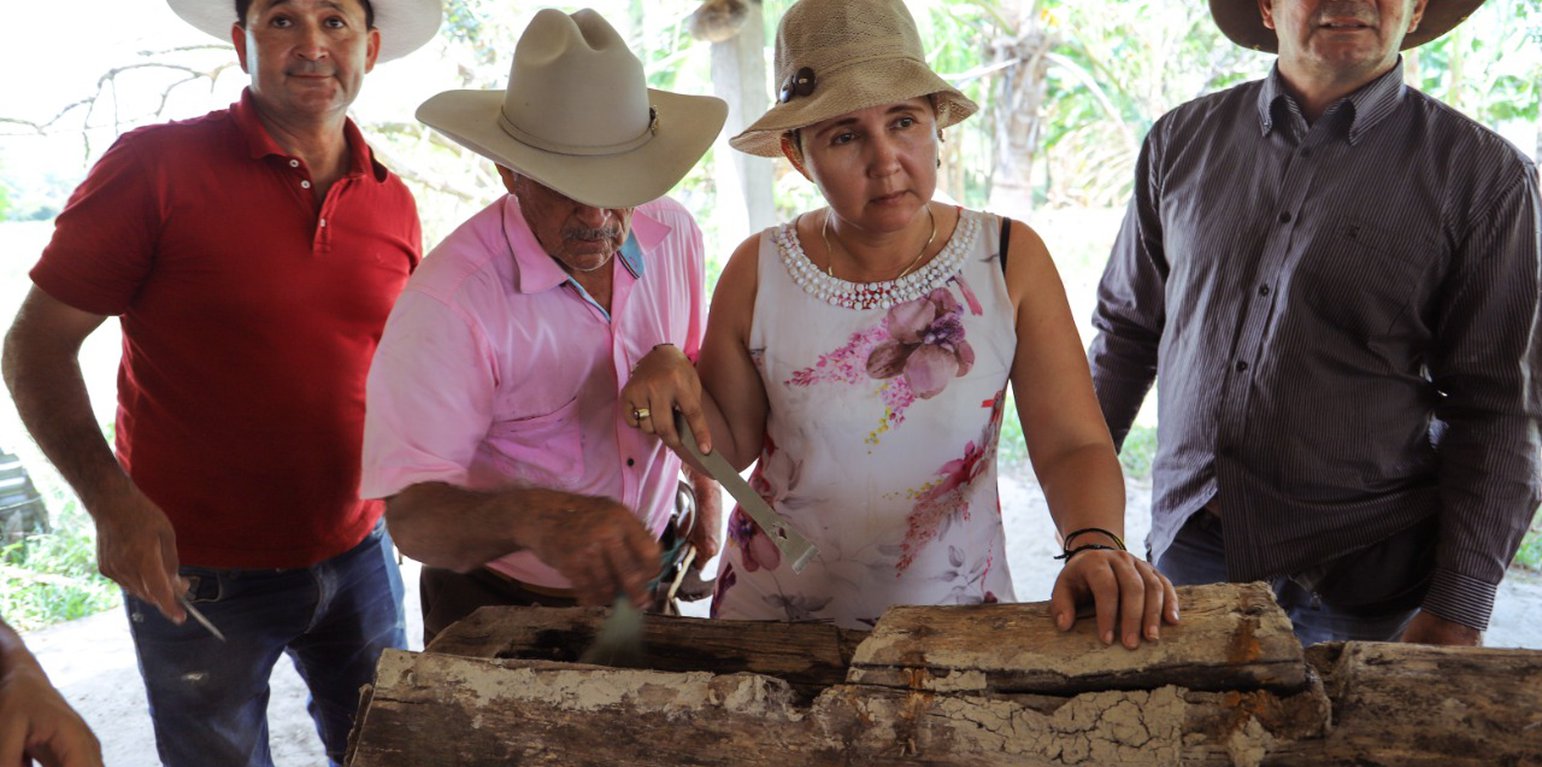



Native bee honey production in the floodable savannahs of the eastern Colombian Llanos (Orinoco River Basin), relies on stingless bees of the species Melipona favosa. These bees nest inside tree trunks. The main characteristics of the native bee keeping, as currently performed by three generations of the Abril Family, is that it is sustainable, promotes de conservation of native ecosystems, and as far as we know, constitutes the only sustainable and profitable direct use of local biodiversity in the floodable savannahs of the eastern Llanos in Colombia. Its sustainability is due to the adaptations and management of the nests, so that honey can be extracted without damaging the bees. On one hand, they know how to retrieve wild nests, either by rescuing them from rotten trees or the ground, or by cutting the branch with the nest, and then keeping its natural position at all times. Once at their houses, they will study the outside of the nest and listen to the bees inside the nest, with this information they will cut out a part of the tree trunk to create a window. Once opened, they verify the location of the honey and pollen pots and the broods. Then, they will reattach the cut part on to the trunk by using metal wire and sealing the edges with mud. The nest will be hanged with wire in the position it was originally found. Once on site they will check every day for the presence of the sentinel bee and bee activity. Furthermore, they only extract honey during the end of the dry season when bees have enough food reserves. For the extraction, they will reopen the previously cut window, and extract the honey and pollen pots, making sure enough are left behind so that bees can have access to food as well. The mean honey production from each nest is around the 750 ml- 1000 ml. Honey is kept for their own use and sold to some people for a fairly high price (30 dollars per 750 ml). The honey is mainly consumed as a medicinal product, and its low quantity makes it highly sought after. If someone requests it for sight issues, Héctor will extract the honey with a syringe so that it is as clear as possible.
The native bee keeping contributes to protect native bees, as the management of nests can keep them functional for up to 30 years. The Abril family members are well aware of the dependency between honey production and presence of native plants from where bees forage for nectar and pollen. Therefore, they avoid forest clearing and selectively keep shrubs in the grasslands to guarantee food supply for their bees. Also, they plant fruit trees such as guayaba (Psidium guajava) and arazá (Eugenia stipitata), that benefit the bees, which at the same time benefit pollination. Fruit production is mainly used for home use and very seldom they are sold. They also witness the negative impacts that agrochemical airborne dispersion from rice production in the neighbouring farms, have on wild bee populations. So far, their main concern is that they do not know how to multiply the nests.
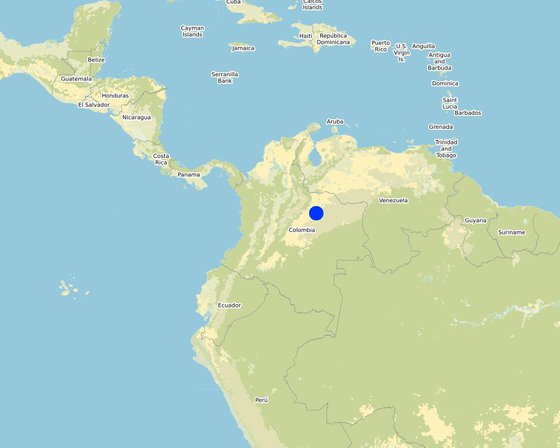
الموقع: Municipality: Trinidad, Vereda: Los Chochos, Casanare, كولومبيا
عدد مواقع تنفيذ التقنيةالتي تم تحليلها: 2- 10 مواقع
انتشار التقنية: يتم تطبيقها في نقاط محددة/ تتركز على مساحة صغيرة
في منطقة محمية بشكل دائم؟: كلا
تاريخ التنفيذ: منذ 10-50 سنة
نوع التقديم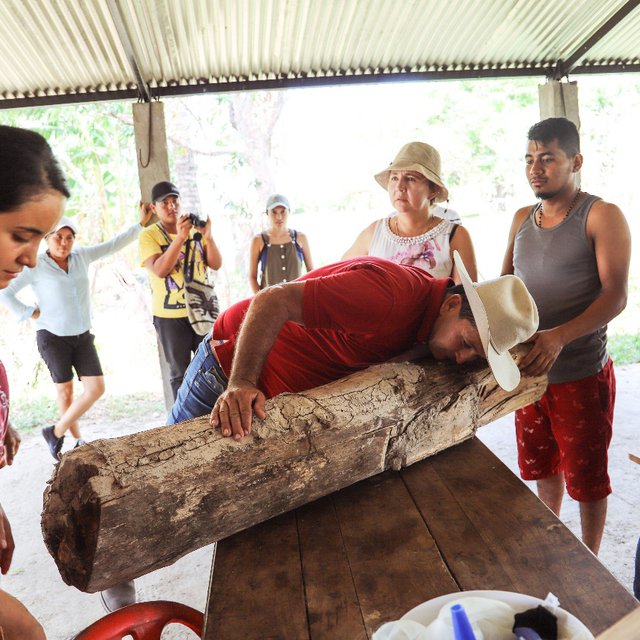


| الصنف | العدد |
| الماشية -لإنتاج اللحوم وليس للألبان | 150 |
| تربية النحل | 80 |







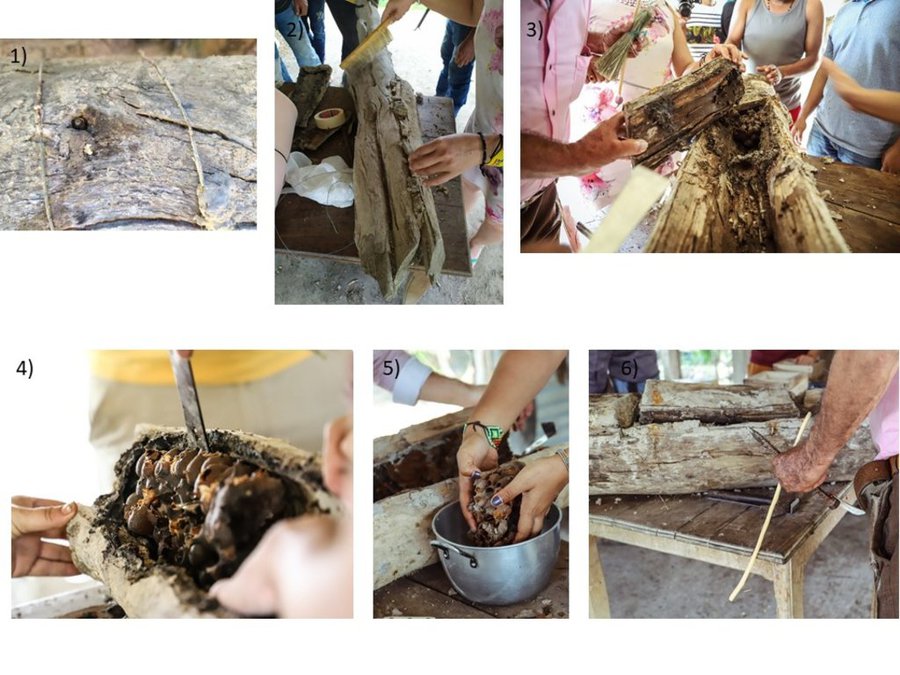
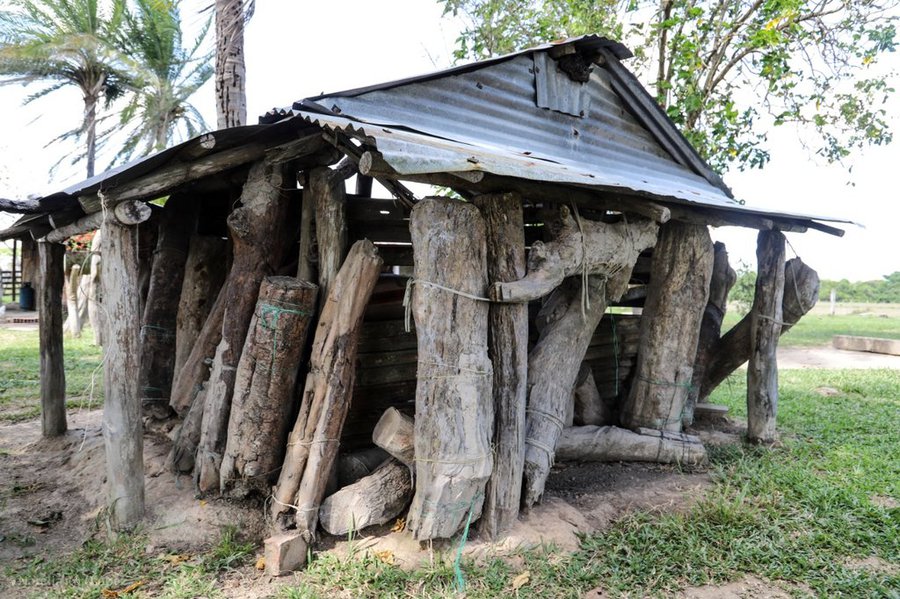
| تحديد المدخلات | الوحدة | الكمية | التكاليف لكل وحدة (دولار أمريكي USD) | إجمالي التكاليف لكل مدخل (دولار أمريكي USD) | % من التكاليف التي يتحملها مستخدمو الأراضي |
| العمالة | |||||
| Two people for wild nest recue or extraction and transport to the house | day | 2,0 | 15,0 | 30,0 | 100,0 |
| Opening of a window in the nest | day | 0,5 | 15,0 | 7,5 | 100,0 |
| Housing construction (two people) | day | 2,0 | 15,0 | 30,0 | 100,0 |
| 100,0 | |||||
| معدات | |||||
| Saw | unit | 1,0 | 20,0 | 20,0 | 100,0 |
| Chissel | unit | 1,0 | 10,0 | 10,0 | 100,0 |
| hammer | unit | 1,0 | 8,0 | 8,0 | 100,0 |
| Metal wire | kilo | 0,5 | 11,0 | 5,5 | 100,0 |
| Ax | unit | 1,0 | 20,0 | 20,0 | 100,0 |
| مواد البناء | |||||
| boles minimum 15 cm diamater and 2 m of height | boles | 4,0 | 8,0 | 32,0 | 100,0 |
| wood support 4 m long | unit | 4,0 | 6,0 | 24,0 | 100,0 |
| Roof laminas (3 m) | laminas | 3,0 | 18,0 | 54,0 | 100,0 |
| Nails | box | 2,0 | 9,0 | 18,0 | 100,0 |
| إجمالي تكاليف إنشاء التقنية | 259.0 | ||||
| إجمالي تكاليف إنشاء التقنية بالدولار الأمريكي | 259.0 | ||||
| تحديد المدخلات | الوحدة | الكمية | التكاليف لكل وحدة (دولار أمريكي USD) | إجمالي التكاليف لكل مدخل (دولار أمريكي USD) | % من التكاليف التي يتحملها مستخدمو الأراضي |
| العمالة | |||||
| Daily check per bee nest | day | 0,005 | 15,0 | 0,07 | 100,0 |
| honey harvest per bee nest (2 people) | day | 1,0 | 15,0 | 15,0 | 100,0 |
| Seedling collection | month | 2,0 | 15,0 | 30,0 | 100,0 |
| Planting of fruitting trees | month | 2,0 | 15,0 | 30,0 | 100,0 |
| معدات | |||||
| Chissel | unit | 1,0 | 10,0 | 10,0 | 100,0 |
| Broom | unit | 1,0 | 3,0 | 3,0 | 100,0 |
| Hammer | unit | 1,0 | 8,0 | 8,0 | 100,0 |
| Syringe | unit | 1,0 | 0,2 | 0,2 | 100,0 |
| Empty glass bottles (750 ml) | unit | 70,0 | 0,4 | 28,0 | 100,0 |
| Table | unit | 1,0 | 30,0 | 30,0 | 100,0 |
| shovel | unit | 1,0 | 20,0 | 20,0 | 100,0 |
| المواد النباتية | |||||
| Bags x 50 units | bag | 1,0 | 5,0 | 5,0 | 100,0 |
| Soil | sack | 4,0 | 6,0 | 24,0 | 100,0 |
| إجمالي تكاليف صيانة التقنية | 203.27 | ||||
| إجمالي تكاليف صيانة التقنية بالدولار الأمريكي | 203.27 | ||||
These farms are in fairly remote area with poor access roads, there is a rural school but for the other services people have to travel for at least 2 hours by car to the closest urban center.
Honey harvesting from collected bee nests
Honey harvesting contributes with about 10% of farm income
Honey harvesting is an additional income source from cattle ranching
Part of the honey and most of the fruits harvested are consumed by the land user theirself.
The preservation of bee nests increases pollinator presence, whilst the conservation of gallery forests preserves habitats for wild bee populations.
allowing for fallows to regenerate for providing bees with resources (nectar, pollen, resins and seeds) increase habitat diversity.
Riparian forest conservation contributed to water regulation